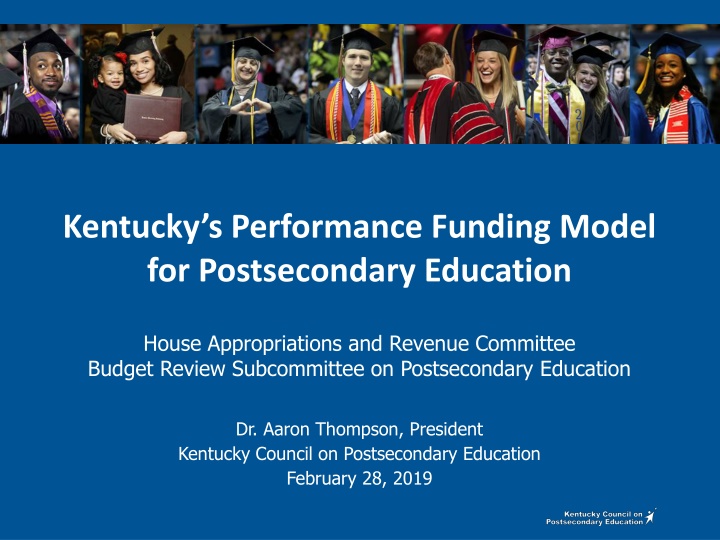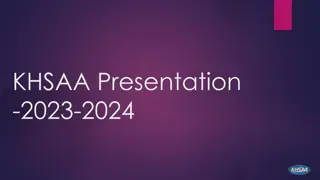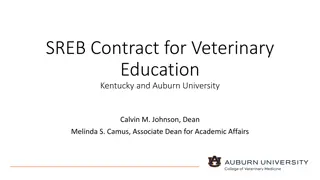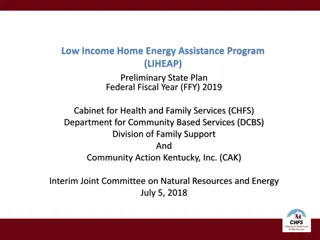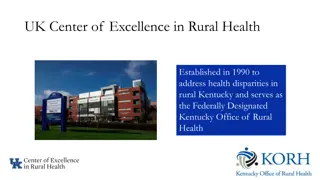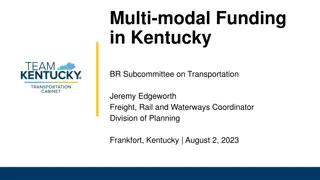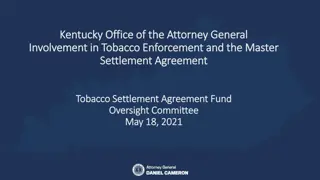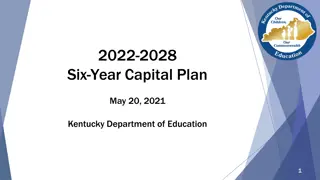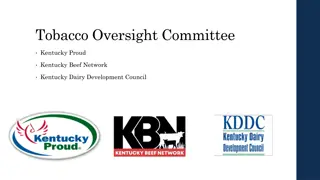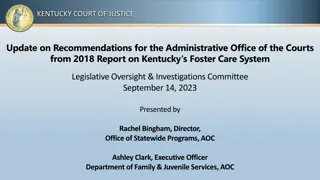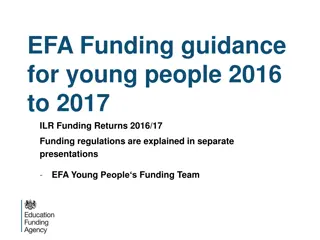Kentucky's Performance Funding Model Overview
Impetus for developing a new performance funding model in Kentucky's postsecondary education system to address disparities, increase educational attainment, and achieve state goals. The model aims to accelerate progress, rectify funding discrepancies, and meet workforce demands. It focuses on increasing retention, degree completion, and credentials, particularly in high-demand fields, while closing achievement gaps for minority and low-income students.
Download Presentation

Please find below an Image/Link to download the presentation.
The content on the website is provided AS IS for your information and personal use only. It may not be sold, licensed, or shared on other websites without obtaining consent from the author.If you encounter any issues during the download, it is possible that the publisher has removed the file from their server.
You are allowed to download the files provided on this website for personal or commercial use, subject to the condition that they are used lawfully. All files are the property of their respective owners.
The content on the website is provided AS IS for your information and personal use only. It may not be sold, licensed, or shared on other websites without obtaining consent from the author.
E N D
Presentation Transcript
Kentuckys Performance Funding Model for Postsecondary Education House Appropriations and Revenue Committee Budget Review Subcommittee on Postsecondary Education Dr. Aaron Thompson, President Kentucky Council on Postsecondary Education February 28, 2019
Overview Impetus for New Model Development Process Components and Metrics Model Mechanics Key Features Current Status 2
Impetus for New Model Accelerate progress toward attainment of state goals for postsecondary education Address shortcomings of previous funding method Rectify funding disparities among institutions that had developed over time Respond to legislative mandate to convene working group and develop model (2016 budget bill, HB 303) 3
Impetus for New Model Kentucky s Big Goal Increase educational attainment of working age adults to 60% by 2030 Currently 45% of KY s population has a postsecondary degree or certificate 60% in 2030 Responds to workforce demands for highly trained, educated population Benefits of increased attainment: higher income (lower poverty) accelerated job growth better life choices and health engaged citizens 45% in 2016 4
Impetus for New Model Specific State Goals (Get Better Faster) Increase retention and progression of students toward timely completion Increase numbers of degrees and credentials earned by all students Produce more degrees and credentials in fields that garner higher wages upon completion (STEM+H fields, high demand fields, targeted industries) Close achievement gaps by growing degrees and credentials earned by minority, low income, and underprepared students 5
Impetus for New Model Shortcomings of Previous Method For more than a decade, state appropriations were distributed based on share of funding received the prior year This approach failed to recognize changes in: Enrollment Program mix Student outcomes (progression, degree completion) No financial incentives for achieving desired state goals for postsecondary education 6
Impetus for New Model Respond to Legislative Mandate The 2016 budget bill (HB 303) directed the Council to establish a working group composed of: The Governor President of Senate (or their representative) Speaker of the House President of each public university and KCTCS Council president Charged to develop a model for allocating state funds that included enrollment, mission, and performance Transferred 5% of each institution s base ($42.9 M, excluding KSU) to a newly created Performance Fund 7
Development Process Funding Model Timeline The working group met five times between April and November 2016 Created a model endorsed by all campus presidents Submitted report to Governor and Interim Joint Committee on Education on December 1, 2016 Formed basis for SB 153, introduced February 2017 It passed the House and Senate with no changes Signed into law by Governor on March 21, 2017 (KRS 164.092) 8
Development Process Consensus Achieved Creating the model required compromise on part of every institution; ultimately consensus was achieved 9
Components and Metrics Major Components/Allocation Percentages Kentucky's Performance Funding Model Distribution of Allocable Resources Student Success 35% Course Completion 35% Share of credit hours earned (weighted for cost differences by course level and discipline) Share of student success outcomes produced Maintenance and Operations 10% Share of facilities square feet dedicated to student learning Academic Support 10% Share of full-time equivalent (FTE) student enrollment Institutional Support 10% Share of spending on instruction and student services 10
Components and Metrics Student Success Metrics Universities Bachelor s degrees earned Degrees per 100 FTE students Bachelor s degrees earned in: STEM+H Fields Bachelor s degrees earned by: URM Students Low Income Students Progression(@ 30, 60, 90 Credit Hours) KCTCS(not included in presentation) 11
Model Mechanics Major Component Funding Pools Kentucky Performance Funding Model Major Components, Allocation Percentages, and Funding Pools Fiscal 2018-19 (Dollars in Millions) Allocation Percentages Component Funding Pools Model Component Distribution Method Share of student success outcomes produced Student Success 35% $181.9 Share of weighted student credit hours earned Course Completion 35% 181.9 Share of facilities square feet dedicated to student learning Maintenance and Operations 10% 52.0 Share of spending on instruction and student services Institutional Support 10% 52.0 Academic Support 10% 52.0 Share of FTE student enrollment Total Allocable Resources 100% $519.8 12
Model Mechanics Student Success Funding Pools Kentucky Performance Funding Model Success Metrics, Allocation Percentages, and Funding Pools Fiscal 2018-19 (Dollars in Millions) Allocation Percentages Student Student Success Metric Success Pool Progression @ 30 Hours 3% $15.6 Progression @ 60 Hours 5% 26.0 Progression @ 90 Hours 7% 36.4 Bachelor's Degrees 9% 46.8 STEM+H Degrees 5% 26.0 URM Bachelor's Degrees 3% 15.6 Low Income Bachelor's Degrees 3% 15.6 Total Student Success Allocable Resources 35% $181.9 13
Model Mechanics Bachelor s Degree Distribution Kentucky Performance Funding Model Distribution of Bachelor's Degree Component Funds Fiscal Year 2018-19 Bachelor's Degree Pool $46,784,400 Weighted Bachelor's Degrees Degree Share Funding Distribution 1 Institution University of Kentucky University of Louisville Eastern Kentucky University Kentucky State University Morehead State University Murray State University Northern Kentucky University Western Kentucky University 7,286 4,843 2,651 307 1,188 1,694 2,285 2,721 31.7% 21.1% 11.5% 1.3% 5.2% 7.4% 9.9% 11.8% $14,836,200 9,861,800 5,397,400 626,100 2,418,800 3,449,100 4,653,900 5,541,100 Total 22,975 100.0% $46,784,400 1Three-year rolling average of bachelor's degrees produced, weighted to promote efficient degree production through use of a degrees per 100 FTE student index and to account for cost and mission differences between the research and comprehensive sectors. 14
Key Features Backs out research and public service appropriations that are not instruction related Applies 50% weighting for credit hours earned by out-of-state students (100% for in-state students) Uses degrees per 100 FTE index to encourage efficient degree production Provides premiums for degrees earned by low income and minority students (and degrees in STEM+H fields) Uses hold harmless and stop loss provisions to provide gradual phase in (max 3% loss, over 3 years) 15
Key Features Premiums for Underserved Populations Kentucky Performance Funding Model Premiums for Low Income and Minority Student Degree Production Fiscal Year 2018-19 Allocation Component Category Percent Weighted Degrees State Funding per Degree Funding Multiple Size of Pool A Bachelor's Degrees 9.0% $46,784,400 22,975 $2,036 1.0 Bachelor's Degrees Low Income Bachelor's $2,036 1,344 B 3.0% $15,594,800 11,606 Low Income Total $3,380 1.7 Bachelor's Degrees Minority Bachelor's $2,036 6,471 C 3.0% $15,594,800 2,410 Minority Total $8,507 4.2 Total Allocable Resources: $519,827,100 16
Key Features Gradual Phase In Fiscal 2017-18 Distribute $42.9 M Performance Fund (KSU Excluded from Model) Fiscal 2018-19 Hold Harmless Maximum Possible Redistribution 3% Over 3 Years Fiscal 2019-20 1% Stop Loss Fiscal 2020-21 2% Stop Loss (Reconvene Working Group) 17
Current Status State funding is no longer being distributed based on historical share Funding based on outcomes is providing incentives for student progression and timely completion Institutions are reacting to the model strategically Most funding disparities that developed over time have been rectified (equilibrium at 6 of 8 universities) Some institutions could see a portion of their funding shift to others beginning in 2019-20 (1% stop loss) 18
Current Status Performance Distribution (2018-19) Kentucky Performance Funding Model Distribution of Postsecondary Education Performance Funds Fiscal Year 2018-19 Institution Distribution University of Kentucky University of Louisville Eastern Kentucky University Kentucky State University Morehead State University Murray State University Northern Kentucky University Western Kentucky University KCTCS $9,119,000 2,507,100 3,387,300 0 0 557,800 4,837,200 3,748,600 6,843,000 Total $31,000,000 The enacted budget for 2018-20 (HB 200) appropriated $31.0 million to the Postsecondary Education Performance Fund in fiscal year 2018-19. These funds are being distributed among institutions according to provisions of SB 153 (2017). 19
Current Status Above Average Performance Kentucky Performance Funding Model Metrics Where Rates of Growth Exceeded Sector Average Between Fiscal Years 2017-18 and 2018-19 Performance Metric Student Success Outcomes Bachelor's Degrees STEM+H Bachelor's Degrees URM Bachelor's Degrees Low Income Bachelor's Degrees Student Progression @ 30 Hours Student Progression @ 60 Hours Student Progression @ 90 Hours Earned Credit Hours Operational Support Activity Instructional Square Feet Direct Cost of Instruction FTE Students UK UofL EKU KSU MoSU MuSU NKU WKU Metrics Above Sector Average 11 6 5 3 5 4 2 1 20
Current Status Funding Model Incentives Enroll and retain greater numbers of academically qualified degree seeking students Encourage students to take full course loads and provide support services to help them progress to timely completion Increase graduation rates and produce more degrees, especially among underserved student populations or in areas of pressing state need Strive to achieve growth rates above sector average on student success metrics 21
